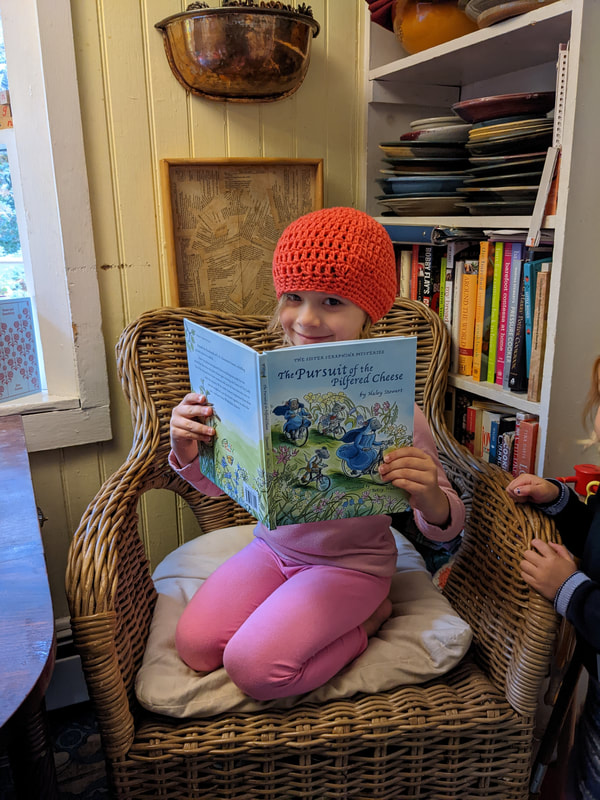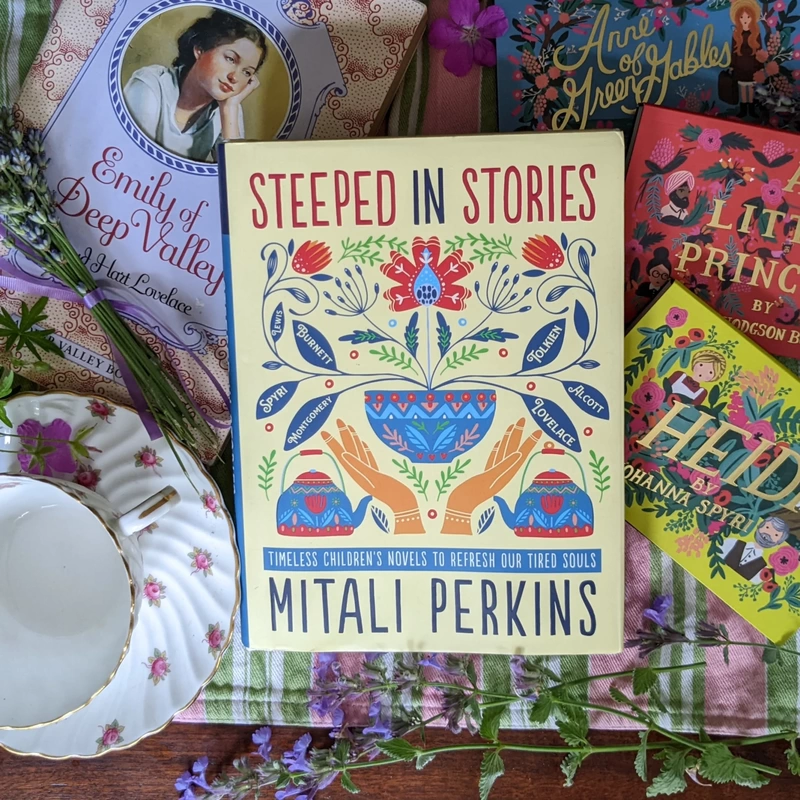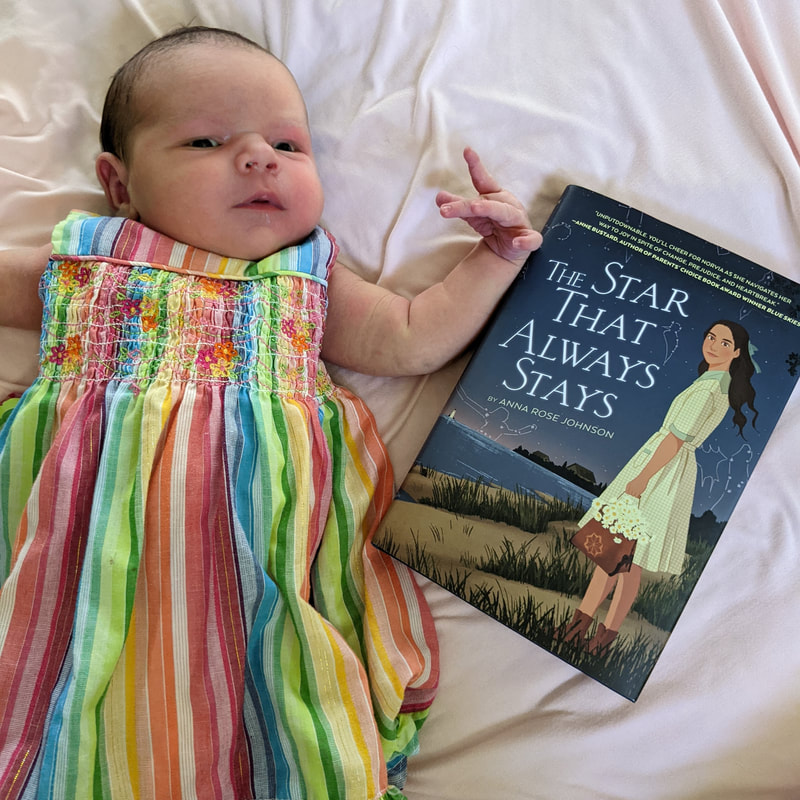|
Happy All Hallow’s Eve! I saved today’s review for today especially because one of the most heart-wrenching yet evocative scenes is a deliciously historical Halloween party. If you loved old-fashioned parties in books like Betsy-Tacy and L. M. Montgomery’s books—you have to find The Star that Always Stays! The Star that Always Stays, by Anna Rose Johnson is a MG historical novel (set in Michigan at the beginning of WWI) that feels like a classic. I read a couple reviews that called it “slow-paced,” but I would argue that “unhurried” is a better word; the pacing is perfect. The story centers around 14-year-old Norvia Nelson, who is struggling to fit into her new stepfamily and new high school while holding onto her Ojibwe heritage. It reminded me of so many of my favorite childhood classics (many of which get some subtle or overt nods throughout the story), but most strongly of Maud Hart Lovelace’s Betsy-Tacy high school stories. I truly loved this story. I loved the style, I loved the plot and the plot construction, I loved the fact that it’s based off the author’s family, and I LOVED the characters. You are going to absolutely fall in love with Norvia’s little sister, Dicta, I guarantee it. While some big families feel somewhat forced, the big family dynamics here were spot on.
But I did have a lot of thoughts and feelings about one element, and I’d love to discuss it with you. A major plot element is Norvia’s mother’s divorce and resulting abandonment of her Catholic faith. Anna Rose Johnson delved deeply into the consequences of one aspect of this: the prejudice and downright meanness with which Norvia’s family was treated as a result of their parents’ divorce and remarriage. My heart broke for Norvia, and I was convicted to be more careful of my own prejudices and pre-conceived ideas. But, as a Catholic, I felt confused that one element was left untouched. To me, leaving my Catholic faith would be a whole lot like abandoning my heritage. While Norvia struggles throughout the book to hold onto her Ojibwe heritage even when it might be difficult, the abandonment of the faith in which she was raised (and which had clearly been important to their family at some point, as evidenced by her sister’s name—Benedicta—and pride in it!) is brushed over very quickly. There don’t seem to be any consequences to it. I imagine that as a Catholic I am more sensitive to this than other readers would be, though it didn’t once stop me from being fully invested in Norvia’s story, watching the way the fall-out from her mother's decisions impacted her life. And of course, it is Norvia’s story, not her mother’s. So what I think of her mother’s decisions are beside the point, in a way (all the more so as this is based on real people!). Another reason this plot point hit me so strongly—in a different way—is that I kept imagining how a book like this would have impacted my own grandmother if she'd had a chance to read it. When she was a young girl and teen, she experienced incredible cruelty from her peers because of her family situation. Her parents were unmarried; her father was terribly abusive; at some point in her childhood, he ended up in prison because of this abuse. My great-grandmother did what she could to protect her children from the gossip and exclusion they were bound to encounter—but one can only do so much. If my grandmother could have read a book like The Star that Always Stays when she was a child, I imagine it would have been incredibly helpful to see another young girl suffering from prejudice and cruelty because of decisions she had no part in. (Note: none of the parents in this story are cruel, though Norvia's father is less than exemplary.) I wonder how many children, like my grandmother, need a story just like this to show them they're not alone. On a totally different, lighter note—modern readers who are interested in diversifying their style should take a look at the marvelous construction of this story. Anna Rose Johnson uses a technique I usually only see in older books (like the aforementioned Betsy-Tacy), of overlapping small plot points to keep the story moving forward and keep the reader engaged without the need to add overdramatic or unrealistic elements just to create tension. The plot of this story is unhurried and simple, but it drips with tension. Very, very well done. Bottom line: I highly recommend this lovely story, especially for lovers of old-fashioned stories and for young teenage readers who may not feel comfortable with the more mature topics in most YA. (Or, you know, adult readers like me who aren’t always comfortable with them, either.) You can purchase The Star that Always Stays from your local bookstore here. For more Marvelous Middle Grade Monday recommendations, check out Always in the Middle!
17 Comments
 My children love mouse stories so much, they once decided to scatter crumbs about my house every evening specifically to make mice feel more welcome in our home. (I am sorry to say, reader, that it worked.) Since they were found out, they gave up their evening mouse feeding, but none of us has lessened our love for little stories with little mouse heroes. Haley Stewart's The Pursuit of the Pilfered Cheese is a worthy successor to Beatrix Potter and Brambly Hedge. If you were wondering how it was possible to improve upon those stories, I'll tell you: mouse nuns. And a mouse abbey in G. K. Chesterton's floorboards. And characters that could have stepped out of a BBC miniseries of his books--if they BBC were ever to cast mice. Here's a little more about the book, from the publisher: Beneath the floorboards of G.K. Chesterton's home, a thrilling pursuit is about to unfold...When the prize cheese at the school fair goes missing, the sisters and students at Saint Wulfhilda's School need all their detective wits to solve the mystery. With some literary inspiration from their upstairs neighbors, can they crack the case--and save their school? What's not to love, right? You can order The Pursuit of the Pilfered Cheese from the publisher, here—and even pre-order the next book in the series while you're at it! For more Marvelous Middle Grade Monday recommendations, check here!  Today’s post is brought to you by 2019 me, reposted from my old blog. I’ve been thinking a lot about this topic lately, as we all struggle with suffering of one kind or another in our lives right now. I hope this will speak to you and encourage you today! “Did you hear about Princess Eugenie’s wedding dress?” my sister asked. “Uh…no?” My family, despite a deep, almost obsessive love for many things British (probably underscored by a passion for good tea and Jane Austen), was never known for following tabloid details of royal family life. Unless this dress happened to be made of hand-woven English tweed, which seemed unlikely (though potentially awesome), I couldn’t quite see why Rose was bringing it up. “She specifically requested a dress design with a low back. It made me think of you.” “Oh…kay.” “Because she wanted her scoliosis scar to be visible. She had the same surgery you did when she was younger, and she said it was important to her that the scar could be seen.” It’s funny how a few words can trigger such a flood of memories: waking up in the recovery bed afraid I was paralyzed because I couldn’t feel my legs…the smell of powdery wildflower perfume the aide wore as she pushed my wheelchair…the searing pain as I struggled to walk a few steps…the way my friend’s faces paled when they saw me try. Later, the slick, coconut-scented sunscreen I poured onto my back every day in summer so my scar wouldn’t burn….the high-backed swimsuits I wore for years so I wouldn’t have to face so many questions. An 20-inch stripe down your back turns out to be an instant awkward conversation starter. I remembered a dialogue between 18-year-old me and my new boyfriend. “I can’t believe how perfect you are for me,” he’d said. A twinge of concern went through me. I wasn’t perfect. Heaven knew I had personality flaws enough to keep my confessor busy the rest of my life. But even physically, my body bore marks of an imperfection I could never get away from. “Not really perfect,” I answered Mark. “I’ve got a giant scar down my back where doctors fused my spine and put stainless steel rods down either side.” Mark’s answer may have changed my life and outlook as much as so few words ever could. “Perfect for me,” he repeated. “And your scar is beautiful.” “Um…I think a little ‘love is blind’ thing is going on here, Mark.” “No, I’m serious! Think about it. Even in His glorified body, Christ still bears the mark of His passion. He has wounds in His hands and feet and sides–even in Heaven, he has scars! I wonder if the scars of the things that helped up get to heaven will be allowed to remain on our risen bodies, too.” He lightly touched the back of my neck, where my scar began. My long hair shielded it from view most of the time, but it was impossible to hide altogether. “Maybe,” he continued, “we’ll know our scars are beautiful when we see them for what they are.” First of all, let’s just clarify, readers, that, yes, of course I knew right then that I was definitely marrying this guy, because who says things like that? Two years later I chose my own wedding dress–not with a deeply plunging back, because I’m way too introverted for that kind of drama, but not high enough to hide my scar completely either. Without that scar, after all, I might not even have been alive to get married–my scoliosis was that severe. A few months after that, pregnant with our first baby, I blessed my surgery and those stainless steel rods for allowing me to bear a child–it even helped to avoid some of the lower back fatigue so many of my pregnant friends experienced since I basically got to walk around with a built-in brace. Back in 1999, soon after my doctors had told me I would need surgery, a priest friend of ours suggested we pray for a miracle of healing. I considered it…but ultimately turned to God in my overdramatic adolescent piety and said, “Okay, listen. I don’t want to be faithless or anything, but it’s hard for me to picture a miraculous healing being very good for me or anyone. Let’s try this: if you want to bring souls closer to you through a healing, you can heal me. If I can help bring more souls to you by suffering through surgery, we’ll do it that way.” Months later, as I lay flat on my back for days and struggled to keep slowly-melting ice chips down–forget about actual food–I rolled my eyes in the general direction of Heaven and thought, “Actually, God, I take it back. This was a bad idea.” But it wasn’t. My suffering helped me grow as a person–much more quickly than an adolescence without trials would have allowed me to. My time in the hospital taught me what joy can be found in service, as I was surrounded by children with far more serious conditions than I had, yet whose faces radiated happiness as they served one another. A little girl without legs wheeled herself from one room to another to read stories to children who couldn’t speak. A toddler twisted with scoliosis smiled out sunbeams at her parents as they played with her and took care of her. Without my own scoliosis, I never would have seen any of this. Mark was right: my scar was not an imperfection but a sign of a step toward perfection–the only perfection that really matters. My physical suffering allowed me to step into the refiner’s fire and come out more radiant than I ever could have been without it. When asked about her dress design, Princess Eugenie said, “I think you can change the way beauty is, and you can show people your scars and I think it’s really special to stand up for that.” Change beauty? Maybe not. But change how we think of it? Absolutely. Beauty is not flawless skin and perfectly straight shoulders (Princess Eugenie’s, like mine, are noticeably uneven because of scoliosis). Beauty can be complicated. Beauty can be harsh. What is more paradoxically beautiful than the Son of God, bleeding and bruised, gazing at us with love from His cross? As Pope Benedict said, “Whoever believes in God, in the God who manifested himself, precisely in the altered appearance of Christ crucified as love…knows that beauty is truth and truth beauty; but in the suffering of Christ he also learns that the beauty of truth also embraces offence, pain, and even the dark mystery of death, and that this can only be found in accepting suffering, not ignoring it.” How many of our scars, both physical and emotional, do we scramble to hide away from the world? Stretch marks…past injustices…surgery scars… Maybe, like Princess Eugenie, we should rather think of a way to display them for what they are: the mile markers on our journey through life, this grand adventure leading us closer to God. Viewed in that way, they’re not ugly at all. They’re perfect.  From the time I was ten to the year I turned thirteen, there was no place I’d rather go than the Millcreek Mall in Erie, PA. Like so many of my peers, I’d beg my mother to drive me over–and like the good mother she was, she’d comply. I’d rush out of the car and into the mall so I could hang out with some of my best friends. The friends happened to be fictional, and my favorite place to go in the mall (really the only place I wanted to go besides maybe the food court) happened to be an in-building branch of the Erie Public Library. But…whatever. I can pretend I was normal. So who were those best friends I spent my tween years with? Anne Shirley, Betsy Ray, Bilbo Baggins, Sara Crewe, Eustace Scrubb. Every character Louisa May Alcott wrote (in her children’s stories, at least). To this day, if you want to become friends with me very quickly, all you need is the implied recommendation of one of my fictional squad. Tell me you’re a fan of Maud Hart Lovelace, and you get to be my friend for life. Recently, a dear friend of mine–one of those women with whom I just instantly connected–came over to my house and saw my [extensive] L. M. Montgomery shelf. “Oh, my goodness!” she said. “This is like my childhood on a shelf. L. M. Montgomery books made me who I am today. They were incredibly formative.” And suddenly our instant connection made sense. We may not have spoken about it right away, but we’d been hanging out in the same crowd for years. Imagine how I felt when I first saw the cover of Mitali Perkin’s non-fiction work, Steeped in Stories. There, right on the dust jacket, was evidence that the author and I were clearly friends who just hadn’t met yet: beautifully emblazoned on illustrated leaves were the names of my favorite creators: Montgomery, Lovelace, Lewis, Tolkien, Burnett, Spyri, Alcott. I was right at home. These are my people. After cracking open the book, I found that Mitali Perkins does indeed love my people just as much as I do–and she loves them enough to ask them some really hard questions. Not out of hatred or woke-ism or whatever you want to call it–but truly out of love and a desire for the truth. Why, Lewis (or “Uncle Jack,” as Mitali calls him), did you use racial stereotypes? How, Aunt Frances [Burnett], could you be so blasé about the destruction British colonialism wreaked upon India? What did you really think, Aunt Maud [Montgomery], about orphans and French Canadians and minorities? In doing so, she allows us to grapple with these same questions while still appreciating all the good to be found in these stories. The good that I found as a lonely tween “military brat” who’d moved around a lot. The good that had formed Mitali as a lonely tween daughter of Bengali immigrants, reading on the fire escape of her New York apartment. In a society that finds it very hard to grapple with problems and find good at the same time (canceling is so much easier, isn’t it?), Mitali Perkins’ book seems almost revolutionary. Instead of ignoring issues, she faces them head-on with love and candor, inviting readers to find solutions by doing so themselves–and, instead of striking books out of our to-read lists and off our shelves, by reading more widely and more diversely. Good, common sense. Add to all this one more element. Mitali organizes her discussion of each story by vice and virtue. Drawing on wisdom from ancient Greece, Thomas Aquinas, the Catechism, and even Pope Francis, she delves into each book’s themes of good and evil in their various incarnations. In doing so, she reminds us yet again that the greatest of children’s literature is not just for children. It is entertaining and beneficial for children, certainly, but we grown-ups are hardly too old for it. If we’re not learning how to be better people through our encounters with Bilbo Baggins and Heidi, we’re not paying enough attention. This review has been a long time coming, as I read Steeped in Stories shortly after its release last year. That happened to be a rather turbulent time in the world and rather full time in my own life. But just like the books she champions, Mitali Perkins’ book provides a panacea to the turbulence and hecticness of life. Steeped in Stories is a lovely reminder that we humans have been in this together for as long as scribes penned stories or raconteurs shared them. If you’ve been feeling overwhelmed or discouraged or scared by the current happenings in the world, then the time is perfect to pull Auntie Mitali’s (may I?) own book and favorite books off the shelves. Steep yourself in the comfort and challenge and reassurance of a good book. (This post was originally published on my old blog, blytheandbold.wordpress.com.) |
About meHi! I'm Faith. I blog about books and creativity, family and faith. Welcome! Archives
November 2023
Categories
All
|

 RSS Feed
RSS Feed